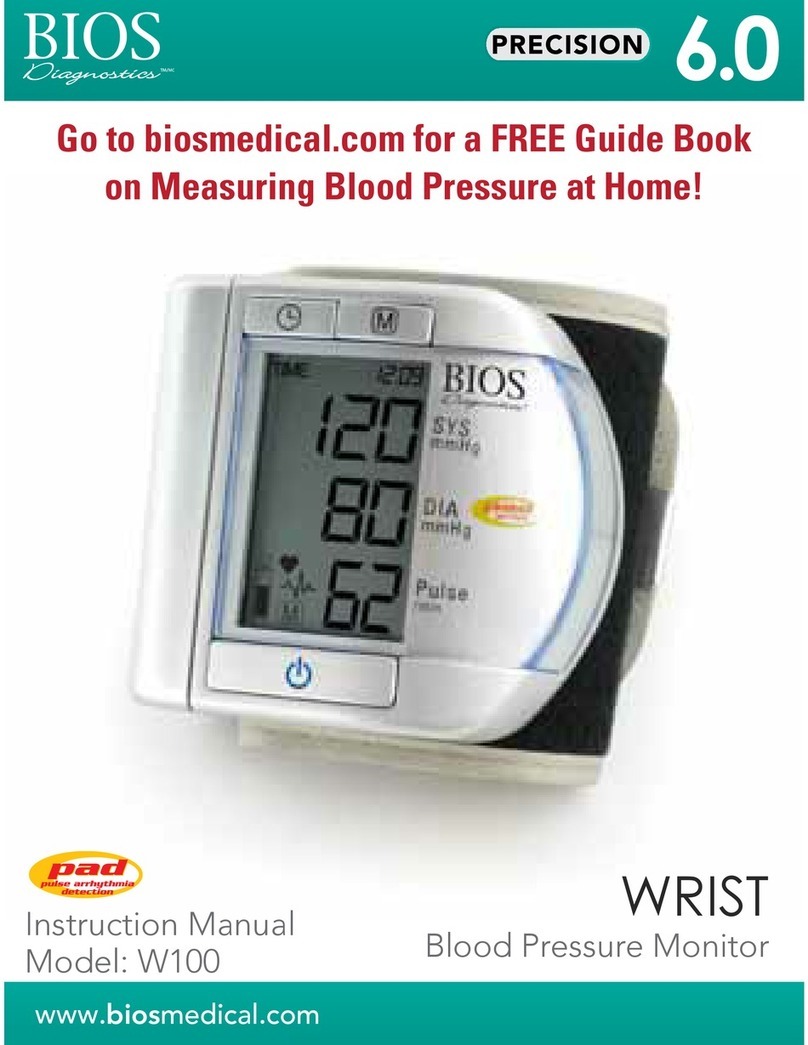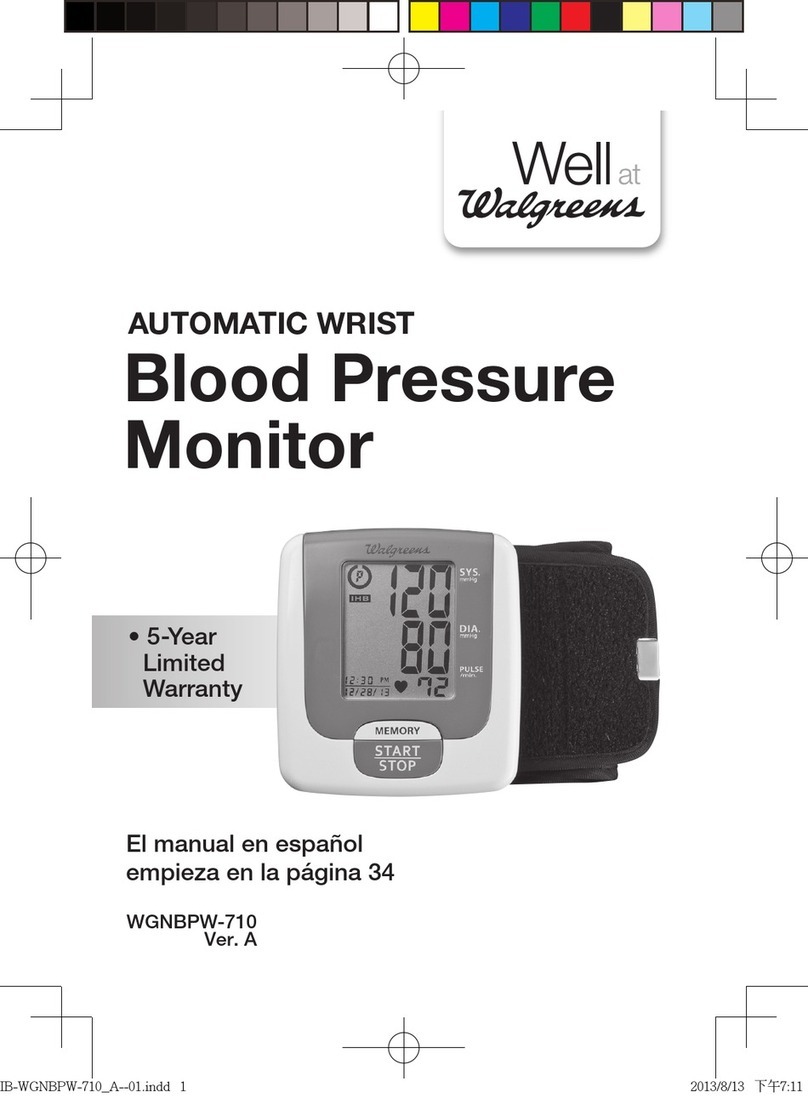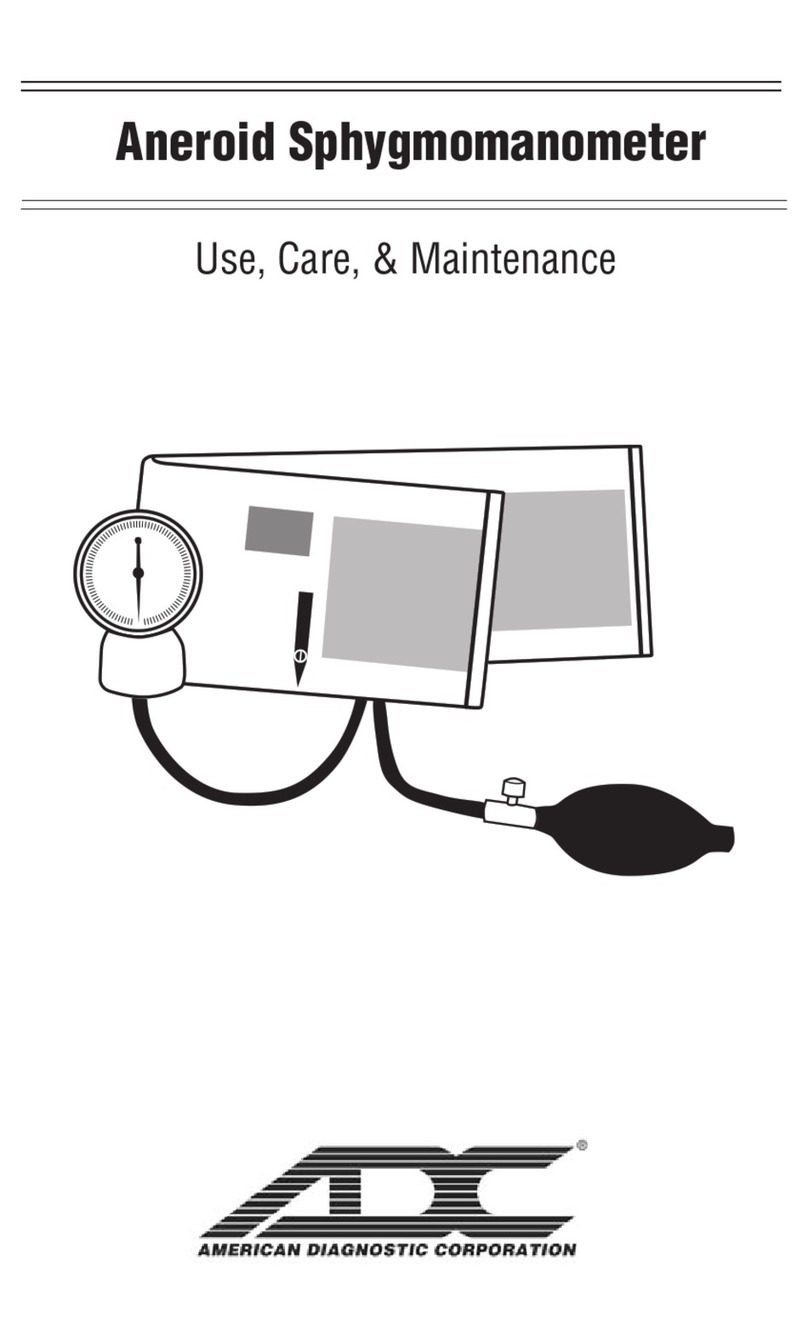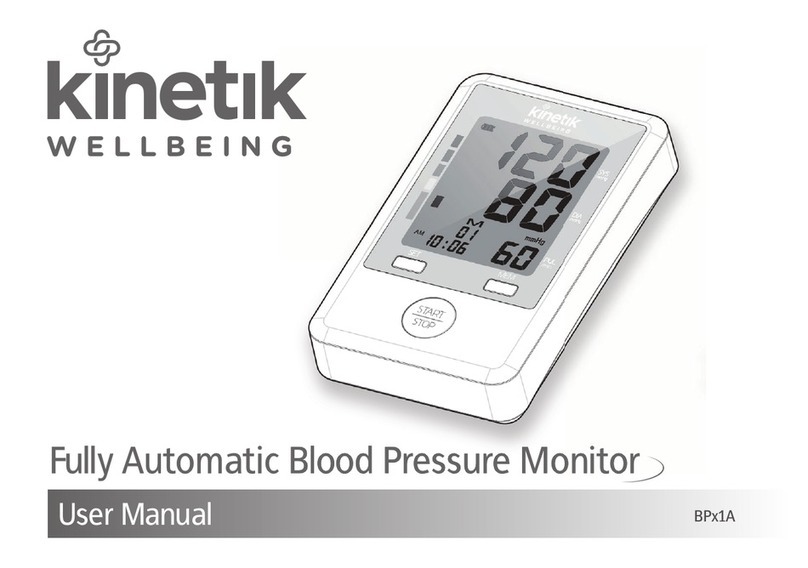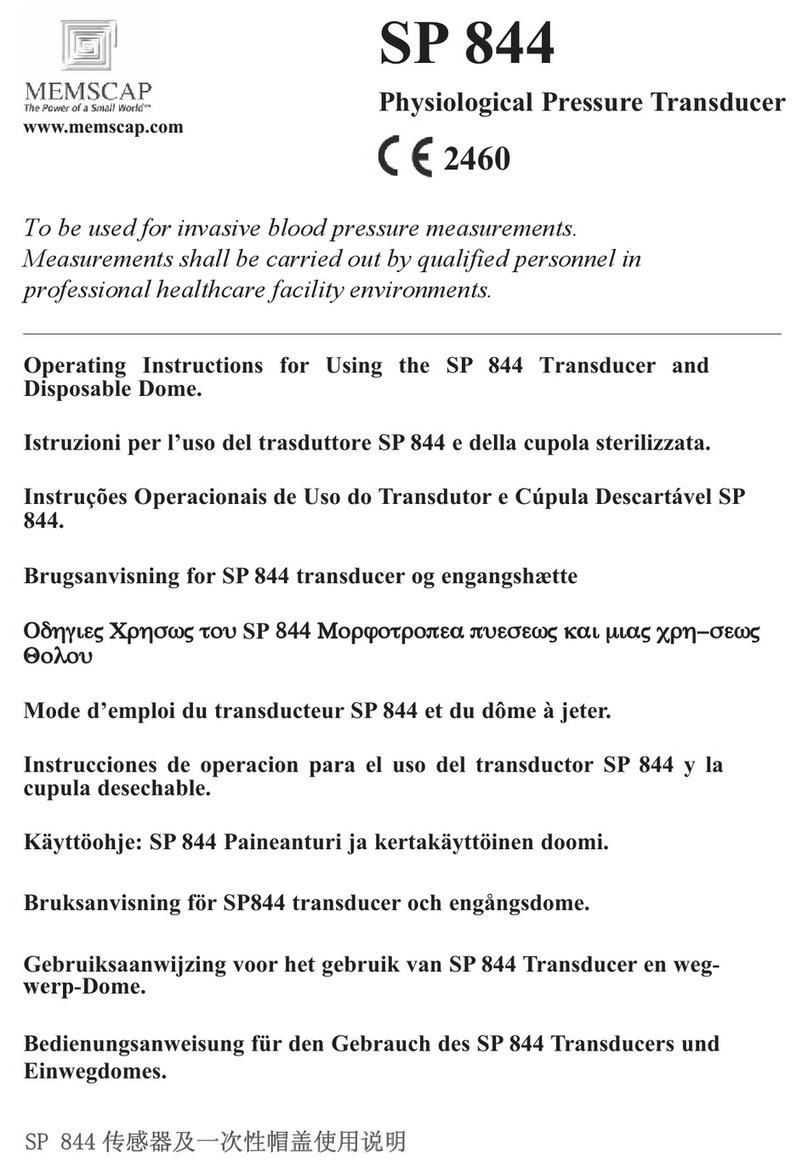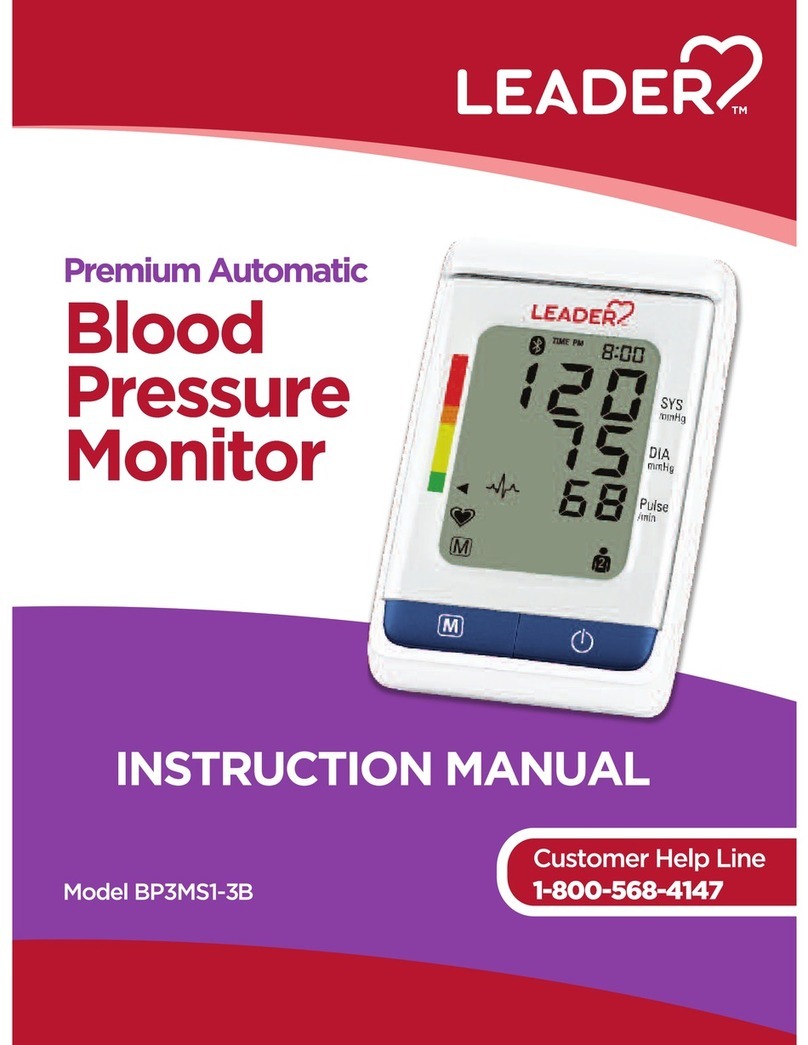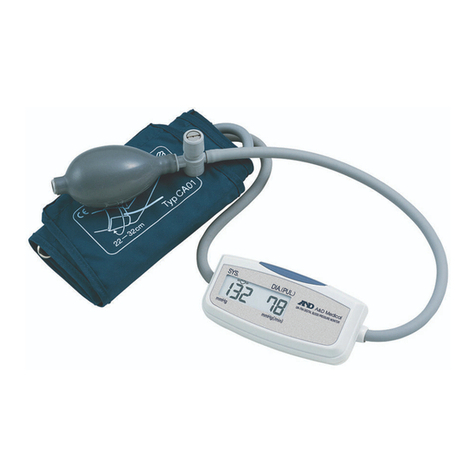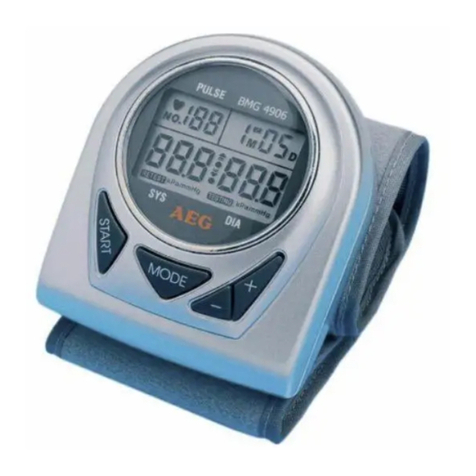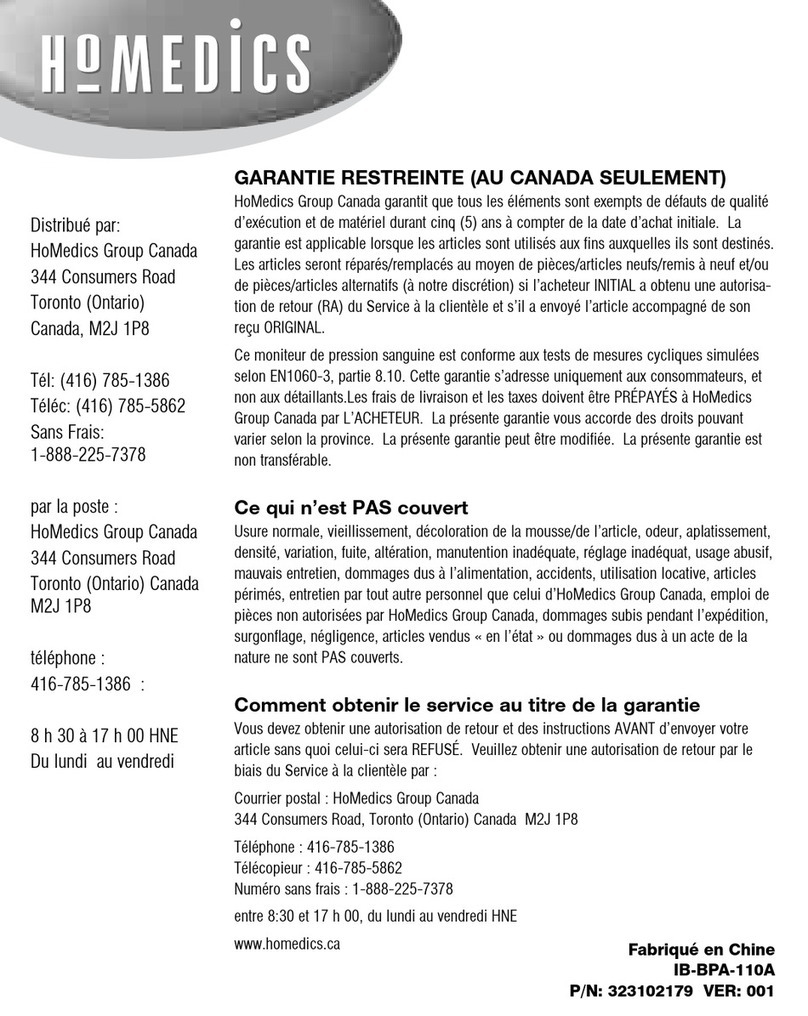BIOS PROTOCOL 7D MII User manual

PROTOCOL®
7D MII
Blood Pressure Monitor
Instruction Manual
Model: BD245
www.biosmedical.com
†‡

Trusted by Canadians for 3 Generations
At BIOS DiagnosticsTM, we are proud of our legacy in blood pressure monitoring in Canada.
From the early 1930’s to 1987 we manufactured “Tycos” brand professional blood pressure
equipment for doctors and hospitals in Canada.
In the 1970’s we pioneered the rst blood pressure devices for monitoring at home, and in the
1980’s we introduced digital technology in Canada. We haven’t been counting, but we know
that millions of our home-use monitors have been used by Canadians in the last 30 years.
All BIOS DiagnosticsTM devices are developed in collaboration with physicians and clinically
tested to prove their measurement accuracy. For more information on clinical tests and other
BIOS medical products, visit our website at www.biosmedical.com.
If you have questions about this device or blood pressure monitoring at home, email us at:
Or: Call the BIOS Medical Hotline 1-866-536-2289
Ofce and manufacturing plant, Church St, Toronto 1934

Table of Contents
1. Introduction
1.1 Features
1.2 Important Information
1.2A Safety Information
1.2B Care of the Device
1.3 About Blood Pressure
1.4 Normal Blood Pressure Values
1.5 Common Blood Pressure Questions and Answers
2. Getting Started
2.1 About the Blood Pressure Monitor
2.2 About the LCD Screen
2.3 Inserting the Batteries
2.4 Using the AC/DC Power Adapter
3. Using the Device
3.1 Select the User
3.2 Setting Time, Date and Year
3.3 Obtaining Accurate Measurements
3.3A Before Measuring
3.3B Common Sources of Error
3.3C Fitting the Wide Range Cuff
3.4 Protocol Software (7D Mode)
3.5 General Mode
3.6 Measuring your Blood Pressure
3.7 Discontinuing a Measurement
3.8 Bluetooth and BP Toolbox APP
3.9 Memory Recall
3.9A Recalling Memory in General Mode
3.9B Recalling Memory in 7D Mode
3.10 Clear Measurements from Memory
3.11 BP Assessment Indicator
3.12 Setting the Alarm
4. Error Messages / Malfunctions
5. Care and Maintenance
6. Lifetime Warranty
7. Technical Specifications
Blood Pressure Monitor
Instruction Manual

1. Introduction
Thank you for purchasing the BIOS DiagnosticsTM Protocol 7DMII Blood Pressure Monitor. Designed for convenient
and easy operation, this device provides a simple, yet accurate method to measure your blood pressure.
Your blood pressure is an important parameter that can be used to monitor your health. This device enables you
to monitor your blood pressure regularly, and maintain a record of your blood pressure measurements. You can
then use this record to assist your physician in diagnosing and maintaining your healthy blood pressure level.
1.1 Features
The blood pressure monitor uses oscillometric technology to measure the arterial blood pressure and pulse rate.
The cuff is wrapped around the arm and automatically inflated by the air pump. The sensor in the device detects
weak fluctuation of the pressure in the cuff produced by extension and contraction of the artery of the arm in
response to each heartbeat. The amplitude of the pressure waves is measured, converted in millimeters of the
mercury column, and is shown on the display.
is preinstalled in the device and simplifies home measurement procedures
recommended by Canadian doctors. Physicians can use the results stored in the tamper-proof log to help
diagnose your individual condition.
2 users, 90 blood pressure readings each with time and date.
- This monitor will connect via Bluetooth to Android and iOS devices. The BP
Toolbox APP enables users to send secure data to physicians for interpretation.
displays the range between which your blood pressure values lie, according
to Hypertension Canada.
- Averages last 3 readings
Time and Date
- Users can set reminders to take measurements at proper times.
This device is easy to use and has been proven in clinical studies to provide excellent accuracy. Before using the
blood pressure monitor, read this instruction manual carefully and keep it in a safe place.
† European Society of Hypertension International Protocol
‡ The blood pressure monitor meets Hypertension Canada’s accuracy standard according to the International
Protocol for automatic blood pressure devices.
1.2 Important Information
Refer to the following sections to learn about important safety instructions and how to take care of the
blood pressure monitor.
your doctor or a physician who is familiar with your family history.
most appropriate time to measure your blood pressure. Never alter the dosages of any medication without
direction from your doctor.

depends on the environment and your state of mind at the time of measurement. In general, your blood
pressure is lower when you are asleep and higher when you are active. Your blood pressure may be higher
when recorded at a hospital or a clinic and may be lower when measured in the relaxing comfort of your
home. Due to these variations, we recommend that you record your blood pressure regularly at home as well
as at your doctor’s clinic.
help your physician detect any extreme variations in your blood pressure and thus treat you accordingly.
risks (heart failure, stroke, angina) associated with “morning hypertension”. There is a typical rise in blood
pressure during the physiological changes from sleep to arising for the day.
and any physical activity, and in the absence of the urge to urinate. If this is not possible, try to take the
measurements later in the morning, before you start any physical activity. Relax for a few minutes before you
record your blood pressure.
— When you are excited, nervous, or tense
— While taking a bath
— During and after exercise or strenuous physical activity
— When it is cold
— Within one hour after meals
— After drinking tea, coffee, or other caffeinated drinks
— After smoking tobacco
— When your bladder is full
— After consuming alcohol
— After taking a bath
diagnosed with a severe arrhythmia or irregular heartbeat, vascular constriction, liver
disorders, or diabetes, have a cardiac pacemaker, or are pregnant, measurements made with this instrument
should only be evaluated after consultation with your doctor.
— Insert batteries with the correct polarity
— Turn off power after use. Remove and store the batteries if you are not planning to use the device
for an extended period of time
— Do not mix different types, brands, or size of batteries. This may cause damage to the product
— Do not mix old and new batteries
— Remove batteries and dispose of them according to the proper regulations in your area
— Do not disassemble batteries or expose them to heat or fire
— Do not short-circuit the batteries
— Do not use rechargeable batteries

1.2B Care of the Device
Do not drop or bang the unit. Prevent sudden jerks, jars, or shocks to the device to prevent damage.
Do not insert any foreign objects in any device openings or vents.
Do not disassemble the unit.
Do not store the unit in direct sunlight, high humidity, or in places with a lot of dust.
Do not use gasoline, thinner or similar solvents. Carefully remove spots
on the cuff with a damp cloth and soap. Do not wash the cuff.
Your blood pressure level is determined in the circulatory centre of your brain. Your nervous system allows your
body to adapt or alter blood pressure in response to different situations. Your body alters your pulse or heart rate
and the width of blood vessels through changes in muscles in the walls of blood vessels.
Your blood pressure reading is highest when your heart pumps or ejects blood. This stage is called your systolic
blood pressure.
Your blood pressure is lowest when the heart rests (in-between beats). This is called your diastolic blood
pressure.
It is critical to maintain blood pressure values within a “normal” range in order to prevent cardiovascular
diseases. Increased blood pressure values (various forms of hypertension) have associated long and medium term
health risks. These risks concern the arterial blood vessels of your body, which are endangered due to constriction
caused by deposits in the vessel walls (arteriosclerosis). A deficient supply of blood to important organs (heart,
brain, muscles) can be the result. Furthermore, with long-term increased blood pressure values, the heart will
become structurally damaged.
There are many different causes of the appearance of high blood pressure. We differentiate between common
primary (essential) hypertension, and secondary hypertension. The latter group can be ascribed to specific organic
malfunctions. Please consult your doctor for information about the possible origins of your own increased blood
pressure values.
Blood pressure is too high when, at rest, the diastolic pressure is above 85 mmHg or the systolic blood pressure
is over 135 mmHg (140 mmHg/ 90 mmHg when taken in medical office).
If you obtain readings in this range, consult your doctor immediately. High blood pressure values over time can
damage blood vessels, vital organs such as the kidney, and your heart.
Should the systolic blood pressure values lie between 135 mmHg and 160 mmHg or the diastolic blood pressure
values lie between 85 mmHg and 95 mmHg, consult your doctor. Regular self-checks will be necessary.
With blood pressure values that are too low (i.e., systolic values under 105 mmHg or diastolic values under
60 mmHg), consult with your doctor.
Even with normal blood pressure values, a regular self-check with your blood pressure monitor is recommended.
This way you can detect possible changes in your values early and react appropriately.

Refer to the following table for classifying blood pressure values (units: mmHg) according to the Canadian Heart and
Stroke Foundation:
Category Systolic Blood Pressure Diastolic Blood Pressure
Optimal < 120 and / or < 80
Normal < 130 and / or < 85
High Normal 130 - 139 and / or 85 - 89
(Measured in office)
(Measure at home)
140 - 159
≥135
and / or
90 - 99
≥85
(Measured in office) 160 - 179 and / or 100 - 109
and / or < 110
Important for Canadians: Hypertension Canada recommends that patients with average
measurements of 135 mmHg (systolic) or 85 mmHg (diastolic) at home be considered
hypertensive. Should your average readings be in this range, consult your physician.
For further information, see our website www.biosmedical.com.
If your values are mostly “normal” under resting conditions but exceptionally high under conditions of physical
or psychological stress, it is possible that you are suffering from so-called ”labile hypertension”. In any case,
please discuss the values with your doctor.
Correctly measured diastolic blood-pressure values above 120 mmHg require immediate medical treatment.
a)
Your blood pressure changes constantly. It is quite normal for blood pressure to fluctuate significantly (50 mmHg
to 60 mmHg) throughout the day. Blood pressure is normally lowest at night, but increases during waking hours
when the stress and activities of everyday life are highest.

mmHg
AM Time PM
Your blood pressure also increases and decreases under the following circumstances
b)
Your blood pressure can vary due to the environment (temperature, nervous condition). When measuring
blood pressure at the doctor’s office, it is possible for blood pressure to increase due to anxiety and tension.
c)
One or two readings will not provide a true indication of your normal blood pressure. It is important to take
regular, daily measurements and to keep records over a period of time. This information can be used to
assist your physician in diagnosing and preventing potential health problems.

2. Getting Started
This section describes the various components of the Blood Pressure Monitor.
a) Blood Pressure Monitor
b) Cuff
Wide range cuff
Cuff connector
Air socket for
cuff connector
AC/DC socket
Set button
User button
Start/Stop button
Memory
button
Wide range cuff for arm circumference 24 - 43 cm or 9.4” - 17”.
Insert the cuff connector into the opening provided on the left side of the monitor as shown in the diagram.
The LCD screen displays the systolic and diastolic blood pressure measurements along with your heart rate. It
also displays previously recorded measurements and the date and time, when the appropriate button is pressed.
User
Blood pressure
classification
Memory symbol
Memory times
Low battery
Heartbeat rhythm
7D Mode
Pulse rate
General mode
Irregular heartbeat
Diastolic blood pressure
Systolic blood pressure
Date/Time

2.3 Inserting the Batteries
Follow these steps to insert four “AA” batteries in to the device.
1. Open the battery compartment cover in the direction shown.
2. Insert four “AA” batteries with the correct polarity as
indicated.
3. Replace the battery compartment cover.
been replaced.
batteries from the device.
rechargeable batteries.
You may also operate this monitor using the included AC/DC
adapter. Use only the included adapter to avoid damaging
the unit.
1. Ensure that the AC/DC adapter and cable are not damaged.
2. Plug the adapter cable into the AC/DC adapter port on the
top of the blood pressure monitor.
3. Plug the adapter into your electrical outlet. When the
adapter is connected, no battery current is consumed.
3. Using the Device
This section describes how to get the maximum benefit from your blood pressure monitor. Follow the
instructions carefully to get an accurate measurement of your blood pressure and pulse rate.
3.1 Select the User
1. Start with the monitor OFF, but with batteries or adapter inserted.
2. Press the / button to switch between User 1 and User 2.
3. Press button to confirm. The monitor will power off.
LR6(AA)
1.5Vx4

1. When the monitor is powered OFF, press the SET button 3 times, the YEAR will
+” or “-” button to choose the year and press SET to store in
the memory.
2. Repeat the same process to set the MONTH by using the “+” or “-” button.
Press the SET button to store it in the memory.
changed with the “+” or “-
4. TIME; hours, and then minutes can be set following the same procedure by using
the “+” or “-” buttons.
5. Next “ +” or “-” buttons to switch between the
alarm being OFF or ON. To set the alarm, select “ ” and press the SET
+” or “-” buttons to change the
HOUR digits. Press the SET button to confirm.
Alarm 1 is set you can also set Alarm 2 following the same steps. (See section 3.12)
7. After the minutes have been set, “ ” will appear on the display. Press the SET button to disregard. See
section 3.10 to clear the memory.
pushing the SET button.
Your blood pressure can vary based on numerous factors, physiological conditions, and your surroundings.
Follow these guidelines to obtain accurate and error-free measurements of your blood pressure and pulse rate.
about 5 minutes before the measurement.
right and left arms while recording your blood pressure as there may be a difference of up to 10mmHg
pressure between the two arms.
during the course of the day. The ideal time to measure your blood pressure is in the morning after you wake
up, before breakfast and physical activity, and in the absence of the urge to urinate.
beginning with the measurement. Remain calm and quiet when the measurement is in process. Do not speak
or move your arm (as well as other body) muscles during the process.
cuff at heart level.
3.3B Common Sources of Error
All efforts by the patient to support the arm can increase the blood pressure. Make sure you are in a
comfortable, relaxed position and do not activate any of the muscles in the measurement arm during the
measurement. Use a cushion for support if necessary.
Hour setting
M

and calm environment. Ensure that you take measurements under the same conditions to obtain an
accurate estimate of blood pressure variation patterns.
measured. Each 15 cm difference in height results in a measurement error of 10 mmHg.
blood pressure measurements should be repeated after at least a 15 second pause or after the arm has been
a) Put the end of the cuff (with fastener) through the metal ring,
making the cuff a cylinder (ignore this step if your cuff is already set
up). Proper assembly allows the Velcro®to match up properly.
b) Place the cuff around your arm. Make sure the bottom edge of the
cuff is about 1” (2-3 cm) above the elbow joint. Adjust the cuff so
that the rubber tubing under the cuff lies over the brachial artery,
which runs on the inside of the arm (see Fig. B). The red material
should be over the brachial artery.
c) Pull the cuff and tighten it by attaching the Velcro®fastener.
Normally, the left arm is used, unless there is a physical reason for
using the right arm.
d) The cuff should fit snugly around the arm, but not too tight. You
should be able to fit two fingers under the cuff.
e) Place the arm on the table (palm facing upwards) so that the cuff is
at the same level as the heart. Make sure there is no kink in
the hose.
d)
e)
c)
a)
b)

f) You can adjust the level of your arm by putting a cushion under
your arm. Ideally the cuff should be at heart level.
g) Remain seated in a comfortable room temperature for at least 5
minutes, then start the measurement.
h) For those who cannot put the cuff on the left arm, put it on the
right arm as shown.
i) Consecutive measurements will cause blood accumulation
in the lower arm which will affect the measuring results. To
improve reading accuracy, raise the arm being measured,
squeeze and relax your hand several times, then take another
measurement. Another option is to take the cuff off and wait
at least 5 minutes before repeating measurement.
j) If this device was stored in low temperature, it is necessary to
leave it in room temperature for at least 1 hour, otherwise the measurement can be inaccurate.
If it is not possible to fit the cuff to your left arm, it can also be placed on the right arm. However all
measurements should be made using the same arm.
Comparable blood pressure measurements always require the same conditions (Relax for several minutes
before taking a measurement).
7D Mode is used in consultation with your physician for assessing white coat hypertension or sustained
hypertension, based on a protocol of measurements taken at home. The protocol calls for 2 measurements to
be taken in the morning (AM) and 2 measurements in the evening (PM) for 7-days consecutively. The blood
pressure monitor will automatically average the measurements according to the protocol and will indicate
whether all data was fulfilled, at the proper times. 7D Mode simplifies the process for users and provides
physicians with clear data from home measurement.
1. When the monitor is OFF, press the SET button, a small triangle will appear above
7D Mode on the monitor. Press the SET button to confirm.
General Mode.
2. Next, select the user. When taking measurements in 7D Mode it is very important
to select the correct user. Press the SET button to confirm, then press the
button to power the monitor OFF.
7D mode General mode
f)
h)
i)

- Rest for 5 minutes before taking a measurement
- Sit at a table with your arm supported and legs uncrossed
- Avoid all movement and muscle tension
- Breathe normally and do not speak
- Wait at least 1 minute between consecutive measurements
- AM & PM measurements should be taken 10-12 hours apart
To start your measurement, see section 3.6 Measuring Your Blood Pressure.
Once the Protocol is complete, after the 7 days, you can view your average. See section 3.9B Recalling Memory
in 7D Mode.
diagnosis.
1. Take 2 measurements in the morning (ideally after going to the bathroom and before eating
or drinking).
and ideally not immediately after the evening meal.
3.5 General Mode
In General Mode, a user can take blood pressure measurements outside of the Protocol
Software (7D Mode).
1. When the monitor is OFF, press the SET button, a small triangle will appear above 7D
Mode on the monitor. Press the “+” or “-“ buttons to switch between 7D Mode and
General Mode. Press SET to confirm.
2. Next, select the user. Press SET to confirm, then press button to power
off the monitor.
3. To start your measurement, see section 3.6 Measuring Your Blood Pressure.
1. Press the button until all the symbols appear on the screen. Right after “
button again to continue with the measurement. You will hear 2 short beeps and after “
the cuff is shown on the display.
7D mode General mode

3. When the device detects a heartbeat, the heart symbol “
you can hear a beep for every heartbeat.
4. When the measurement has been completed, you will hear a long beep and the systolic,
diastolic and pulse rate will appear on the display.
5. The measurement readings remain on the display until you switch off the device. If no button
is pressed, the device switches itself off in 3 minutes.
The symbol “ ” will be displayed along with the reading if irregular heartbeat has been
detected during the measurement. If the “ ” symbol appears frequently (e.g. several
times in a week), it may be an indication of a more serious heart problem, and you
should consult your doctor.
3.7 Discontinuing a Measurement
To stop the measurement (eg. the patient feels unwell) press the button. The device will
immediately decrease the cuff pressure automatically.
1. To begin using the free BP Toolbox APP, download and install it onto your smartphone or tablet.
BP Toolbox
2. Turn ON Bluetooth on your device.
3. Open the BP Toolbox APP. You will need to register and create
a password.
4. Once in the APP, select Menu Settings Select User. Select
User 1 or 2
5. Next, scroll down on the Menu to Patient Info and fill out your information
and press
6. You can now sync your BP monitor to the APP. On the BP monitor, press
the button, all symbols will appear on the screen, right
after “ scroll
down to Bluetooth and press Scan For Devices to connect the BP monitor
(see figures 1-4). The name of the BP monitor should appear on the
screen, select the BP monitor name and press Confirm. The BP monitor
and APP should successfully connect.
7. If connection is successful, the BP monitor will sync to the APP and the
memory from the monitor will download onto the APP.
Figure 1
Figure 3
Figure 2
Figure 4

You should see the memory count down on the BP monitor as its
downloading the measurements to the APP. If there are no measurements this will not happen.
8. Once the memory download is complete, you can take your measurement. When the measurement is completed
the monitor will sync with the APP automatically.
This blood pressure monitor automatically stores 90 measurements for each user in its memory. The 90
oldest record will be replaced by the latest measurement value when there are more than 90 sets for each user.
First select General Mode, then press the “-“ button to see the most recent measurement value. Subsequent
measurements can be displayed one after the other by continuously pressing the “-“ or “+”button.
7D mode General mode 7D mode General mode 7D mode General mode
First select 7D Mode, then press the “+” or “-“ button.
A. If the Protocol was done correctly, the monitor will display “ ”, meaning all 28 measurements have
been saved in the memory, and then display the Average Measurement as per the Protocol software. In the
Average Measurement screen the date will display the second day the Protocol measurements were started
and then change to the 7th day the Protocol measurements ended.
If the first day of measurements are started on October 10th and ends 7 days later on October
17th, the date will appear as 10M11Dthen change to 10M17Dand back and forth . 10M11Dwill display instead
of 10M10Dbecause the Protocol disregards the first day of measurements and averages the last 6 days of
measurements. See section 3.4 for more explanation.
Press the “+” or “-“ button to display the subsequent measurements.
7D mode General mode 7D mode General mode 7D mode General mode 7D mode General mode 7D mode General mode
B. If the Protocol was done incorrectly or if any measurements were missed, the monitor will display “ ”
then “ ” then the average measurement and then display the subsequent measurements.

7D mode General mode 7D mode General mode 7D mode General mode 7D mode General mode
7D mode General mode
Reasons why the Protocol Software is displaying
- Not enough measurements have been saved in memory. For the Protocol Software to work there needs to be
28 measurements saved in memory, 4 measurements taken for 7 days.
If you are sure that you want to permanently remove all stored memories, first choose the mode you want to delete
the memory from, then press the SET button 9 times until “CL” appears when the power is off. Press the
button until “CL” flashes 3 times to clear the memory. After this, press either the “+” or “-” button, the
symbols “ ” and “no” will appear on the screen. This means that the memory has successfully cleared.
The bars on the left hand side of the display show you the range within which the indicated blood pressure
values lies. Depending on the height of the bar, the readout value is either within the normal (green), borderline
(yellow) or danger (red) range.
The classification is based on standards adopted by Hypertension
Canada.
The indicator bar rises according to your measurement.
measurement is in the green zone, or “Normal”.
“High Normal”.
Blood Pressure with Self / Home Monitoring”.
“Moderate to Severe Hypertension”.
This blood pressure monitor allows you to set two alarm times at which an alarm signal will then be triggered.
This can be a useful aid, for instance as a reminder to take your measurements for the Protocol Software (7D
Mode) or to remind you to take medication.
1. To set the alarm, while the monitor is OFF, press the SET button 8 times, “ “+”
or “-“ buttons to switch between the alarm being OFF or ON. Select “ ” and press the SET button. The
“+” or “-“ buttons to change the HOUR digits, press SET button to confirm.
“+” or “-“ buttons to change the digits, press SET to confirm.
3. Once Alarm 1 is set, you can follow the same steps above to set Alarm 2.
SYS
14 5
135-14 5
95
85-95
80-84
71-80
70
121-134
110-120
110
(mmHg) DIA
Red
Red
Yellow
Green
Green

4. Error Messages / Malfunctions
If an error occurs during a measurement the LCD displays the corresponding error code.
Error Possible Cause
Weak signal or a sudden change in pressure Ensure that the cuff is worn correctly and
measure again. Avoid movement or talking
External disturbance (eg. if there is a cell
phone near by)
Electromagnetic interferance can cause odd
behaviour in the monitor. Move away from
the source.
Appears when there is an error during the
Make sure the cuff is wraped around the
arm properly and that the air plug is properly
connected to the unit.
Abnormal Blood Pressure Rest for 5 minutes and try measurement again
In 7D Mode - Protocol was not done correctly
Delete all measurements from the memory.
Start Protocol again. Take 4 measurements a
day (2 in the morning, 2 in the evening) for 7
days straight.
Low battery Replace batteries.
If problems occur when using the device the following points should be checked, and if necessary, the
corresponding measures should be taken.
Malfunction
The display remains blank when the device is
switched on.
1. Check batteries for correct polarity.
2. If using the AC adapter, ensure it is correctly
inserted.
The pressure does not rise even though the pump is
running. Check the connection of the cuff tube and connect
properly, if necessary.
The device frequently fails to measure the blood
pressure values, or the values measured are too low
or too high.
1. Check the positioning of the cuff and cuff tension.
The cuff should be snug but not tight.
2. Measure the blood pressure again, ensuring that
you have remained motionless for a sufficient
amount of time to ensure an accurate reading.
Every measurement produces varying results
although the instrument functions normally and the
values displayed are normal.
therefore measurements will show some variability.
Blood pressure values measured differ from those
measured by the doctor.
Record the daily developement of the values and
consult your doctor.
blood pressure reading than at home.

5. Care and Maintenance
a) Do not expose the device to either extreme temperatures, humidity, dust or
direct sunlight.
b) The cuff contains a sensitive air-tight bubble. Handle this carefully and
avoid all types of stress through twisting or buckling.
c) Clean the device with a soft, dry cloth. Do not use gas, thinners or similar
solvents. Spots on the cuff can be removed carefully with a damp cloth and
soapsuds.
d) Handle the tube carefully. Do not pull on it. Do not allow the tubing to kink
and keep it away from sharp edges.
e) Do not drop the monitor or treat it roughly in any way. Avoid strong vibrations.
f) This invalidates the manufacturer’s warranty.
g) Batteries and electronic instruments must be disposed of in accordance with
the locally applicable regulations, not with domestic waste.
6. Lifetime Warranty
This BIOS DiagnosticsTM blood pressure monitor has a Lifetime Warranty to be free of manufacturing defects for
the life of the original owner. This warranty does not include the inflation system including the cuff and inflation
bladder. The cuff is warranted for 2 years. The warranty does not cover damage from misuse or tampering.
100% Satisfaction Guarantee
If at any time, you are not completely satisfied with the performance of this device, call our BIOS Medical Hotline and
speak with a customer service person, who will make arrangements to have the device repaired or replaced to your
full satisfaction.
If you have questions regarding the operation of your monitor call the
BIOS Medical Hotline: 1-866-536-2289
M
START
STOP
M
START
STOP
M
START
STOP
M
START
STOP

Should repair be necessary, return the unit with all component pieces. Enclose proof of purchase and $5.00 for
return shipping and insurance. Ship the unit prepaid and insured (at owners option) to:
Email: [email protected]
Please include your name, return address, phone number, and email address. Thermor will repair or replace (at
Thermor’s option) free of charge any parts necessary to correct the defect in material or workmanship.
Please allow 10 days for repair and return shipping.
7. Technical Specifications
5 to 40°C / 41 to 104°F
-20 to 55°C / -4 to 131°F
287 g (not including batteries)
139 x 100 x 46 mm
Oscillometric during deflation
0 – 299 mmHg
Pulse 40 – 199 beats per minute
1 mmHg
Pressure within ± 3 mmHg
± 5% of the reading
4 x 6 V Batteries; size AA
AC adapter
Technical alterations reserved
Made in China
Read the instruction manual carefully before using this device, especially the safety instructions, and keep
the instruction manual for future use.
Type BF applied part
Batteries and electronic devices must be disposed of in accordance with the locally applicable regulations,
not with domestic waste.
WWW.BIOSMEDICAL.COM
This manual suits for next models
1
Table of contents
Other BIOS Blood Pressure Monitor manuals


